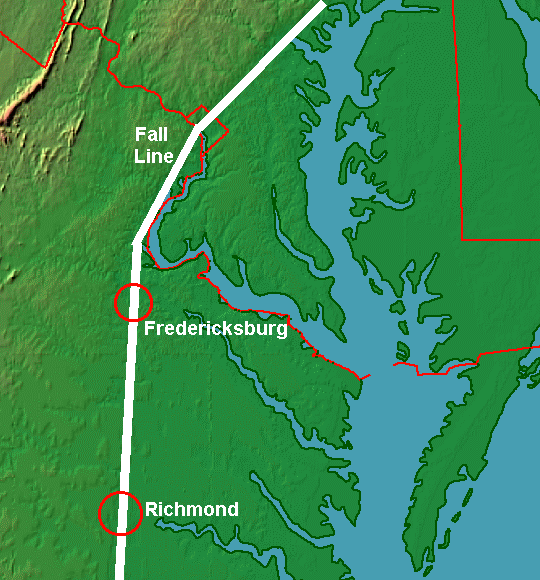How the Fall Line Shaped Powhatan's Area of Control

when the English arrived in 1607, the natural geologic boundary of the Fall Line created millions of years ago (shown as brown line) was also a cultural boundary between Algonquian-speaking and Siouan-speaking tribes
Source: Virginia Department of Mines, Minerals and Energy, Generalized Geologic Map of Virginia
Prior to the settlement at Jamestown, Powhatan had inherited control of about a half-dozen tribes near the Fall Line of the James and Pamunkey Rivers. He then conquered 25 or so other Algonquian groups to establish his paramount chief status.
This authority over others did not make Powhatan unique. In South Florida, the Calusa crystallized into a complex chiefdom (or weak tribute-based state) after the Spanish arrived, even though the society was non-agricultural. The chief of the Calusa, based at Mound Key near modern-day Fort Myers, was collecting tribute from 20,000 people when he met with the Spanish in 1566.1
By 1607, Powhatan's area of control (known as Tsenacommacah) was large, but still limited to areas east of the Fall Line. His rivals, the Monacan and the Manahoac, lived upstream beyond the Fall Line in the James River and Rappahannock River watersheds.
By the time Christopher Newport led the Susan Constant, Godspeed, and Discovery to Jamestown Island, Powhatan dominated much of Tidewater Virginia up to the Rappahannock River, and perhaps beyond to the Potomac River in some places. He controlled the Eastern Shore, a long canoe ride across the Chesapeake Bay, but the nearby Piedmont west of the Fall Line remained outside of his control. Powhatan raided across the Fall Line, but never settled the area upstream of it.
Why did Powhatan establish control over other Algonquian tribes east of the Fall Line, rather than reach a simple alliance with them and focus on defeating the rivals - with a different language - who lived upstream?
If the English had not arrived, perhaps Powhatan might have expanded his area of control to the west. He was consolidating power over fellow Algonquian-speaking tribes in 1607. His suppression of the Chesapeake tribe had occurred very recently, just before or after the English arrived.
One reason Powhatan may have started with establishing control east of the Fall Line: the other tribes in Tidewater could access the protein-rich waters of the Chesapeake Bay estuary, with oysters, crabs, and fish in abundance during certain seasons of the year. Based on the potential to generate food, the lands in Tidewater were more valuable than the lands above the Fall Line.
Those Siouan-speaking tribes in the Piedmont were not completely isolated from the Chesapeake's food resources. They had access to anadromous fish and eels that were able to swim above the falls to spawn throughout the James River, York, and Rappahannock tributaries. The mature forests on the Piedmont also provided extensive nut crops (including chestnuts), and the flocks of passenger pigeons and other birds were a food resource based on the forests of the Piedmont.
- NOTE: The English did seek out trading relationships with Powhatan's rivals. Initially, residents at Jamestown were almost completely dependent upon Tidewater tribes under Powhatan's control to provide food. Once he became the leader in the colony, John Smith sought to bypass Powhatan. Smith, and then following colonial leaders, tried to trade with tribes on the Potomac where Powhatan's authority was weak, and the Algonquian leader could not enforce his strategy of withholding food from the English.
The early English explorations among the Manahoac failed to establish a regular pattern of trade with any tribes above the Fall Line. Why didn't the English trade with the Manahoac?
In addition to the opposition of Powhatan, the logistics of shipping food from the Piedmont to the English at Jamestown were too cumbersome. There were no roads from the rapids in the rivers to the west, just footpaths. To follow those, the English were dependent upon Native American guides. Meat and corn are bulky and heavy, and the English lacked horses or mules to serve as pack animals. (As late as 1700, most crops were still planted the Native American way, using a digging stick to "drill" a hole for placing seeds in the soil rather than plowing entire fields with a horse, mule, or ox.)

Fall Line - compare to Powhatan's western boundary
Links
References
1. Victor D. Thompson, William H. Marquardt, Karen J. Walker, Amanda D. Roberts Thompson, Lee A. Newsom, "Collective action, state building, and the rise of the Calusa, southwest Florida, USA," Journal of Anthropological Archaeology, Volume 51, September 2018, https://doi.org/10.1016/j.jaa.2018.05.003 (last checked June 28, 2018)
The Real First Families of Virginia
Virginia Places

